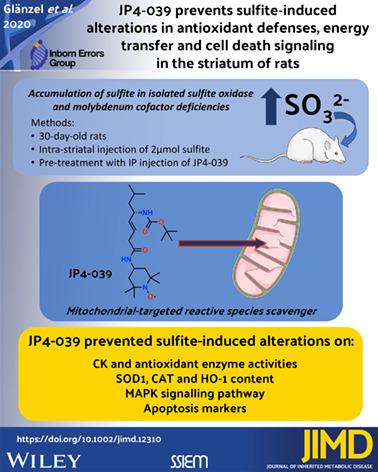当前位置:
X-MOL 学术
›
J. Inherit. Metab. Dis.
›
论文详情
Our official English website, www.x-mol.net, welcomes your
feedback! (Note: you will need to create a separate account there.)
The mitochondrial‐targeted reactive species scavenger JP4‐039 prevents sulfite‐induced alterations in antioxidant defenses, energy transfer, and cell death signaling in striatum of rats
Journal of Inherited Metabolic Disease ( IF 4.2 ) Pub Date : 2020-09-03 , DOI: 10.1002/jimd.12310 Nícolas Manzke Glänzel 1 , Mateus Grings 1 , Nevton Teixeira da Rosa-Junior 1 , Leila Maria Cereta de Carvalho 1 , Al-Walid Mohsen 2, 3 , Peter Wipf 4 , Moacir Wajner 1, 5, 6 , Jerry Vockley 2, 3 , Guilhian Leipnitz 1, 5
Journal of Inherited Metabolic Disease ( IF 4.2 ) Pub Date : 2020-09-03 , DOI: 10.1002/jimd.12310 Nícolas Manzke Glänzel 1 , Mateus Grings 1 , Nevton Teixeira da Rosa-Junior 1 , Leila Maria Cereta de Carvalho 1 , Al-Walid Mohsen 2, 3 , Peter Wipf 4 , Moacir Wajner 1, 5, 6 , Jerry Vockley 2, 3 , Guilhian Leipnitz 1, 5
Affiliation

|
Sulfite oxidase (SO) deficiency is a disorder caused either by isolated deficiency of SO or by defects in the synthesis of its molybdenum cofactor. It is characterized biochemically by tissue sulfite accumulation. Patients present with seizures, progressive neurological damage, and basal ganglia abnormalities, the pathogenesis of which is not fully established. Treatment is supportive and largely ineffective. To address the pathophysiology of sulfite toxicity, we examined the effects of intrastriatal administration of sulfite in rats on antioxidant defenses, energy transfer, and mitogen‐activated protein kinases (MAPK) and apoptosis pathways in rat striatum. Sulfite administration decreased glutathione (GSH) concentration and glutathione peroxidase, glucose‐6‐phosphate dehydrogenase, glutathione S‐transferase, and glutathione reductase activities in striatal tissue. Creatine kinase (CK) activity, a crucial enzyme for cell energy transfer, was also decreased by sulfite. Superoxide dismutase‐1 (SOD1) and catalase (CAT) proteins were increased, while heme oxygenase‐1 (HO‐1) was decreased. Additionally, sulfite altered phosphorylation of MAPK by decreasing of p38 and increasing of ERK. Sulfite further augmented the content of GSK‐3β, Bok, and cleaved caspase‐3, indicating increased apoptosis. JP4‐039 is a mitochondrial‐targeted antioxidant that reaches higher intramitochondrial levels than other traditional antioxidants. Intraperitoneal injection of JP4‐039 before sulfite administration preserved activity of antioxidant enzymes and CK. It also prevented or attenuated alterations in SOD1, CAT, and HO‐1 protein content, as well as changes in p38, ERK, and apoptosis markers. In sum, oxidative stress and apoptosis induced by sulfite injection are prevented by JP4‐039, identifying this molecule as a promising candidate for pharmacological treatment of SO‐deficient patients.
中文翻译:

线粒体靶向活性物质清除剂 JP4-039 可防止亚硫酸盐引起的大鼠纹状体抗氧化防御、能量转移和细胞死亡信号的改变
亚硫酸盐氧化酶 (SO) 缺乏症是一种由 SO 的孤立缺乏或其钼辅助因子合成缺陷引起的疾病。它的生化特征是组织亚硫酸盐积累。患者表现为癫痫、进行性神经损伤和基底节异常,其发病机制尚未完全确定。治疗是支持性的,但基本上是无效的。为了解决亚硫酸盐毒性的病理生理学问题,我们研究了大鼠纹状体内施用亚硫酸盐对大鼠纹状体的抗氧化防御、能量转移、丝裂原活化蛋白激酶 (MAPK) 和细胞凋亡途径的影响。亚硫酸盐给药降低了谷胱甘肽 (GSH) 浓度和谷胱甘肽过氧化物酶、6-磷酸葡萄糖脱氢酶、谷胱甘肽 S-转移酶、和纹状体组织中的谷胱甘肽还原酶活性。亚硫酸盐也降低了肌酸激酶 (CK) 活性,它是细胞能量转移的关键酶。超氧化物歧化酶-1(SOD1)和过氧化氢酶(CAT)蛋白增加,而血红素加氧酶-1(HO-1)减少。此外,亚硫酸盐通过降低 p38 和增加 ERK 来改变 MAPK 的磷酸化。亚硫酸盐进一步增加了 GSK-3β、Bok 和裂解的 caspase-3 的含量,表明细胞凋亡增加。JP4-039 是一种线粒体靶向抗氧化剂,其线粒体内水平比其他传统抗氧化剂更高。亚硫酸盐给药前腹腔注射 JP4-039 保留了抗氧化酶和 CK 的活性。它还可以防止或减弱 SOD1、CAT 和 HO-1 蛋白含量的改变,以及 p38、ERK、和凋亡标志物。总之,亚硫酸盐注射诱导的氧化应激和细胞凋亡被 JP4-039 阻止,确定该分子是 SO 缺乏患者药物治疗的有希望的候选者。
更新日期:2020-09-03
中文翻译:

线粒体靶向活性物质清除剂 JP4-039 可防止亚硫酸盐引起的大鼠纹状体抗氧化防御、能量转移和细胞死亡信号的改变
亚硫酸盐氧化酶 (SO) 缺乏症是一种由 SO 的孤立缺乏或其钼辅助因子合成缺陷引起的疾病。它的生化特征是组织亚硫酸盐积累。患者表现为癫痫、进行性神经损伤和基底节异常,其发病机制尚未完全确定。治疗是支持性的,但基本上是无效的。为了解决亚硫酸盐毒性的病理生理学问题,我们研究了大鼠纹状体内施用亚硫酸盐对大鼠纹状体的抗氧化防御、能量转移、丝裂原活化蛋白激酶 (MAPK) 和细胞凋亡途径的影响。亚硫酸盐给药降低了谷胱甘肽 (GSH) 浓度和谷胱甘肽过氧化物酶、6-磷酸葡萄糖脱氢酶、谷胱甘肽 S-转移酶、和纹状体组织中的谷胱甘肽还原酶活性。亚硫酸盐也降低了肌酸激酶 (CK) 活性,它是细胞能量转移的关键酶。超氧化物歧化酶-1(SOD1)和过氧化氢酶(CAT)蛋白增加,而血红素加氧酶-1(HO-1)减少。此外,亚硫酸盐通过降低 p38 和增加 ERK 来改变 MAPK 的磷酸化。亚硫酸盐进一步增加了 GSK-3β、Bok 和裂解的 caspase-3 的含量,表明细胞凋亡增加。JP4-039 是一种线粒体靶向抗氧化剂,其线粒体内水平比其他传统抗氧化剂更高。亚硫酸盐给药前腹腔注射 JP4-039 保留了抗氧化酶和 CK 的活性。它还可以防止或减弱 SOD1、CAT 和 HO-1 蛋白含量的改变,以及 p38、ERK、和凋亡标志物。总之,亚硫酸盐注射诱导的氧化应激和细胞凋亡被 JP4-039 阻止,确定该分子是 SO 缺乏患者药物治疗的有希望的候选者。











































 京公网安备 11010802027423号
京公网安备 11010802027423号